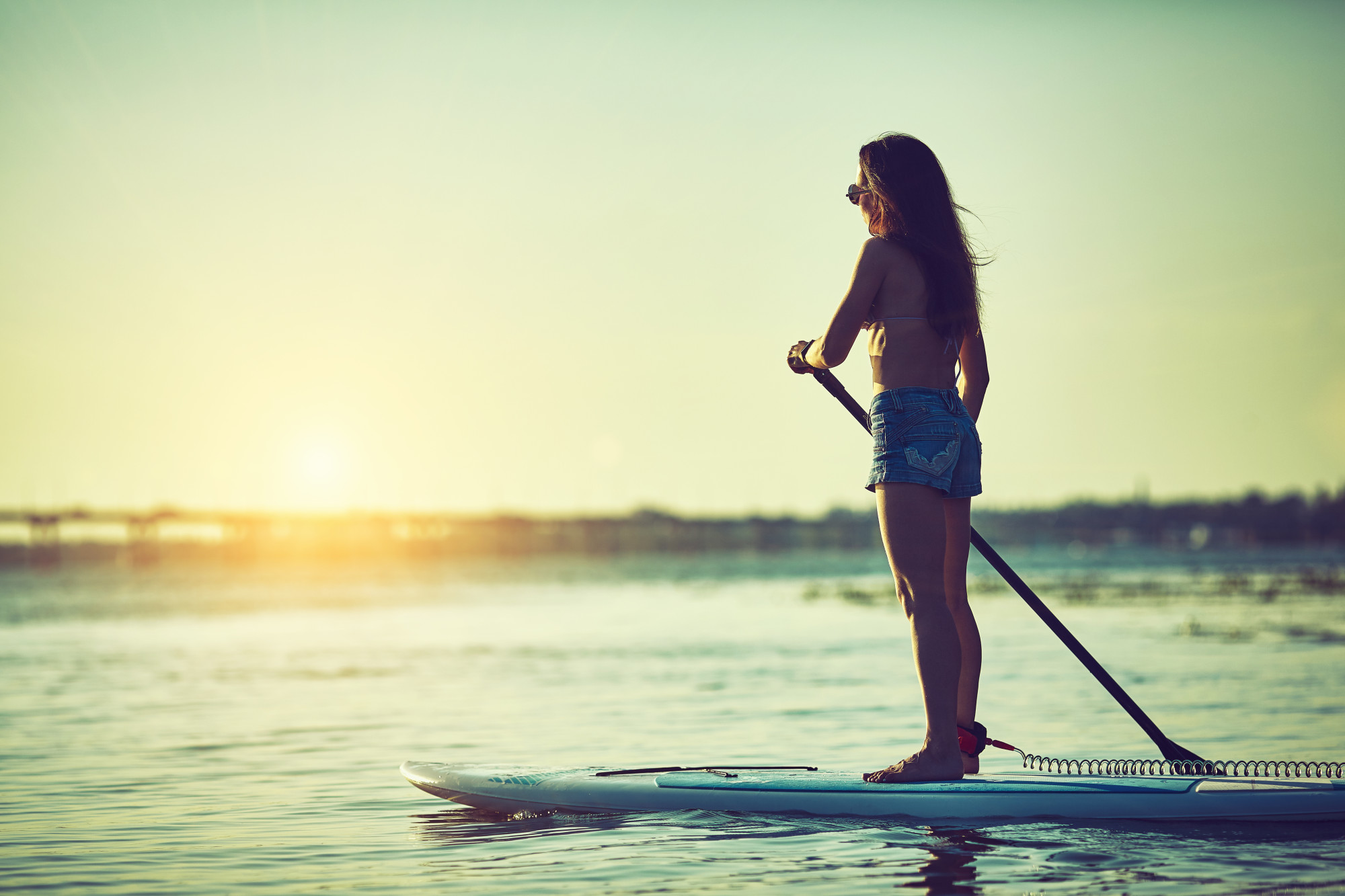If you’ve decided to give stand up paddle boarding, also known as SUP, a try, this guide will go over everything you need to know to get started. Once you get the hang of this invigorating and relaxing activity, you’ll be hooked.
Stand up paddle boarding is something you can enjoy on oceans, lakes or rivers while getting an all-body workout at the same time.
From what equipment you need, to the different types of stand paddle boards and the different strokes, you’ll be paddle boarding like a pro in no time.
Table of Contents
What is Stand up Paddle Boarding?
You can think of stand up paddle boarding like kayaking and surfing all in one. This outdoor water sport involves the rider, using paddles to move through the water while standing on a large board.
For more information on stand up paddle boarding, this guide has all of the basics covered.
Stand up paddle boarding is a great form of exercise. This all-body workout, works your core, your arms, as well as your legs. It’s also a great way to see the world on the water.
How to Choose a Stand Up Paddle Board
When you first consider stand up paddle boarding, it might be best to go with a friend or rent a paddleboard. This can help you feel out if it’s right for you.
If you’ve decided it’s something you have to do more of, there are few things to consider when purchasing your board. Choosing a board will first depend on your weight, skill level, and intended use.
You’ll also want to keep in mind where you’ll be venturing out on your board. Different boards can help you through ocean waves or calm bays.
There are also boards specifically made for every different time of stand up paddle boarding activity. From recreational paddle boarding to surfing, touring, and yoga, deciding how you want to use your board will help narrow down your choice.
How to Choose Your Paddle
The first piece of equipment to consider for your stand up paddle boarding adventures is the paddle. The paddle looks like a canoe paddle that is slightly more stretched out.
There is a tear-drop shaped blade at the end of the paddle that angles forward. This helps maximize your paddling efficiency. When you stand the paddle up in front of you, raise your arm above your head. The paddle should reach up to your wrist.
See also How To Choose A Paddle Board
Stand Up Paddle Board Equipment and Safety Gear
Every stand-up paddler, needs a few pieces of equipment for safety reasons. The first is a life vest or personal flotation device.
A paddle board is classified as a vessel by The U.S. Coast Guard. This means that all children have to wear a personal flotation device even in a surf or swimming area. Adults only need to wear one if they are paddling outside of a swimming or surf area.
It’s also required to have a light on your board if you’re out after sunset. You also need to wear a whistle according to U.S. Coast Guard regulations to warn other boaters of your presence if need be.
Check with your state to see the different regulations and age requirements.
What to Wear Stand Up Paddle Boarding?
If you’re paddle boarding over the summer, you can go right in your swimsuit. You can also wear board shorts and a long or short-sleeved rash guard to protect you from the sun.
If you’re paddle boarding when the weather is colder, wear a wet or dry suit to keep you warm and prevent against hypothermia if the conditions require it.
Leashes are also a good thing to keep for safety. These are often sold separately but you can get a leash that will tether you to your board. You can use your board as a flotation device in case of emergency.
Depending on where you go paddle boarding, you’ll want a leash that is designed for flat water, rivers, and surf.
The last thing you should always wear is a sunscreen with SPF. No one wants a sunburn while out enjoying the water. Sunglasses, a hat and a rash-guard or other sun-protective clothing is also a good idea.
How to Stand Up Paddle Board
First-time paddle boarders can usually get the hang of it pretty quickly. The more you practice, the more comfortable you get with the strokes and different bodies of water.
To start, stand next to the board in knee-deep water. You want it deep enough that the fins don’t hit the bottom. Next, hold the board at the edges. Kneeling, slowly work your way onto the board.
When you get to the center, keep your hands on the sides to hold yourself stable. Move your feet one at a time where your knees were at the center. Don’t just stand up here. Raise your chest up slowly while keeping your knees bent.
Extend your legs to standing once your chest is vertical. Once you’re standing, move your feet to a parallel position. Your feet should be hip-width apart. They should also be located in the center of the board.
From here, keep your towel pointed forward, your back straight, and your knees slightly bent. Keep your eyes up staring level at the horizon. Try not to look down at your feet.
Stand Up Paddle Board Strokes
To hold your paddle, make sure the tear-drop shape of the blade is angled toward the nose. When you’re paddling, keep the opposite hand on the T-grip. Your other hand will be down by the shaft of the paddle.
When you switch sides, you will reverse your hand positions. When you’re paddling on the right side, for example, keep your left hand at the T-grip. Then put your right hand down onto the shaft.
There are three different strokes you can use while stand up paddle boarding. The strokes include the forward stroke, the reverse stroke, and the sweep stroke.
Choosing Your First Outing
You’ve purchased your board, your paddle, and your safety equipment. Now, you’re ready to head out on your first adventure stand up paddle boarding. To start, stick with calm shallower water. A bay is a great place to begin.
Lather up some sunscreen, and hit the board running. Don’t worry if it takes you a while to stand up. Once you get going you’ll be enjoying your board and your new hobby for many years to come.
For some inspiration on where to go for your first paddle board adventure, visit the travel section for some trip ideas.



















